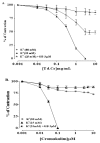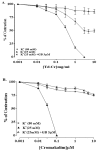The Potential Involvement of an ATP-Dependent Potassium Channel-Opening Mechanism in the Smooth Muscle Relaxant Properties of Tamarix dioica Roxb
- PMID: 31717691
- PMCID: PMC6920928
- DOI: 10.3390/biom9110722
The Potential Involvement of an ATP-Dependent Potassium Channel-Opening Mechanism in the Smooth Muscle Relaxant Properties of Tamarix dioica Roxb
Abstract
Background: Tamarix dioica is traditionally used to manage various disorders related to smooth muscle in the gastrointestinal, respiratory, and cardiovascular systems. This study was planned to establish a pharmacological basis for the uses of Tamarix dioica in certain medical conditions related to the digestive, respiratory, and cardiovascular systems, and to explore the underlying mechanisms. Methods: A phytochemical study was performed by preliminary methods, followed by HPLC-DAD and spectrometric methods. In vivo evaluation of a crude hydromethanolic extract of T.dioica (TdCr) was done with a castor-oil-provoked diarrheal model in rats to determine its antidiarrheal effect. Ex vivo experiments were done by using isolated tissues to determine the effects on smooth and cardiac muscles and explore the possible mechanisms. Results: TdCr tested positive for flavonoids, saponins, phenols, and tannins as methanolic solvable constituents in a preliminary study. The maximum quantity of gallic acid equivalent (GAE), phenolic, and quercetin equivalent (QE) flavonoid content found was 146 ± 0.001 μg GAE/mg extract and 36.17 ± 2.35 μg QE/mg extract. Quantification based on HPLC-DAD (reverse phase) exposed the presence of rutin at the highest concentration, followed by catechin, gallic acid, myricetin, kaempferol, and apigenin in TdCr. In vivo experiments showed the significant antidiarrheal effect of TdCr (100, 200, and 400 mg/kg) in the diarrheal (castor-oil-provoked) model. Ex vivo experiments revealed spasmolytic, bronchodilatory, and vasorelaxant activities as well as partial cardiac depressant activity, which may be potentiated by a potassium channel opener mechanism, similar to that of cromakalim. The potassium channel (KATP channel)-opening activity was further confirmed by repeating the experiments in glibenclamide-pretreated tissues. Conclusions: In vivo and ex vivo studies of T.dioica provided evidence of the antidiarrheal, spasmolytic, bronchodilator, vasorelaxant, and partial cardiodepressant properties facilitated through the opening of the KATP channel.
Keywords: HPLC-DAD; KATP channel opener; Tamarix dioica; antidiarrheal; bronchodilator; spasmolytic; vasodilator.
Conflict of interest statement
The authors declare no conflict of interest.
Figures















References
-
- Samejo M.Q., Sumbul A., Shah S., Memon S.B., Chundrigar S. Phytochemical Screening of Tamarix dioica Roxb. Ex Roch. J. Pharm. Res. 2013:181–183. doi: 10.1016/j.jopr. - DOI
-
- Mahmood A., Shaheen H., Qureshi R.A., Sangi Y., Gilani S.A. Ethnomedicinal survey of plants from district Bhimber Azad Jammu and Kashmir. Pak. J. Med. Plants Res. 2011;5:2348–2360.
-
- Zaidi S.F., Muhammad J.S., Shahryar S., Usmanghani K., Gilani A.-H., Jafri W., Sugiyama T. Anti-inflammatory and cytoprotective effects of selected Pakistani medicinal plants in Helicobacter pylori-infected gastric epithelial cells. J. Ethnopharmacol. 2012;141:403–410. doi: 10.1016/j.jep.2012.03.001. - DOI - PubMed
Publication types
MeSH terms
Substances
LinkOut - more resources
Full Text Sources

